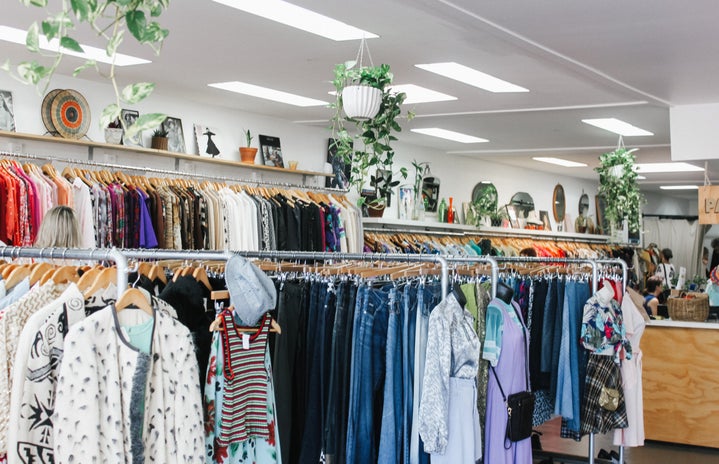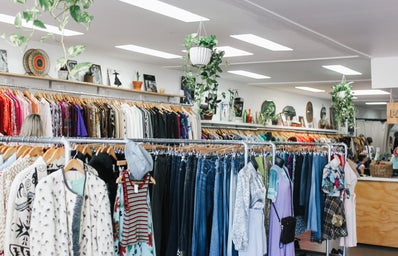Every Earth Day consists of the same grateful posts crediting mother nature with some of our most aesthetic nature pictures. Although this is a great way to show all of what Earth gives us it in no way contributes to what we can do to keep Earth this beautiful. If we don’t stop and contribute to helping Earth then one day we’ll be posting about how beautiful Earth once was.
Not many people know that the fashion industry is the second-largest polluter in the world, just after the oil industry. From the production, manufacturing, and transportation, the clothes we wear are hurting the planet. A small step in the right direction is to hold fast fashion companies like SHEIN, Fashion Nova, Forever21, and H&M accountable for the over-production of clothes that ultimately end up polluting the planet. Trends like sweater vests, tennis skirts, and corset tops will go out of style soon, but their remains might end up in landfills forever. Instead of consumers constantly purchasing trendy pieces from the same fast fashion brands a good alternative to look into are sustainable fashion brands that produce timeless pieces.
“Fast fashion is fashion that is made really quickly and in abundance. It’s super overproduced and over-consumed. It’s meant to be disposable: if you buy a piece and it goes out of style the next week then you can buy a new piece later. It’s cheap for that reason,” Natalia Trevino Amaro, a slow fashion designer stated.
Natalia Trevino Amaro created her slow-fashion brand in June of 2020 just after graduating from the Fashion Institute of Technology. Since then she has gone on to produce several collections of sustainable fashion pieces made from deadstock and personal scrap fabric she had leftover from other projects.
Her pieces sell out in minutes after launching on her website. She is also known for her outstanding communication with customers. If customers are between sizes she suggests they send her their measurements to get it custom made to their specific size. This ensures that the customer will receive a garment that perfectly fits their body and are comfortable in.
Despite the success of her business, many critics believe the prices of her pieces should be lowered. It’s a comment that is repeatedly told to her about her brand. To this Amaro explains that when clothing is priced at a very low price it means someone isn’t getting paid for their work. She also knows that the switch from fast fashion to sustainable fashion deals very heavily with changing the mindset of how much clothing really costs.
“It’s just such a switch of mindset and you have to think: what am I really paying for? If something is priced at $100, where is that $100 really going? 20% is probably cost and material, 30% to 50% could be the labor (paying the worker), after that it could go towards profits so the company can continue to grow and succeed in being sustainable. When you break it down it gives you an explanation of what you are paying for when buying from a sustainable company.” Amaro stated.
The biggest advice Amaro gave when switching to sustainable clothing is to think of quality over quantity.
“It’s so easy to see fast fashion hauls of 20 to 30 items of clothing and that’s totally normal for them…but that’s not how you’re supposed to buy sustainable fashion. You’re supposed to buy very little, one to two pieces maybe a month at most,” Amaro stated. “By doing this you’re buying quality over quantity which is hard to do when you’re used to buying a lot of cute trendy clothes for so little.”
The change while difficult is worth it when understanding that fast fashion hauls mask the over-production and waste they are putting on the planet as well as the treatment of their workers. Sustainable fashion brands are known for having information on their brand easily available for customers to access. This allows customers to know what they are paying, what they are supporting, and who they are supporting. Ultimately deciding to switch from fast fashion to sustainable fashion is not only beneficial for the planet, but for your closet as well. Trendy clothing goes out of style as fast as they emerge, but sustainable brands produce timeless staple pieces that are meant to last.
“At the end of the day, I feel better about buying something even if it’s three times the price I actually want to pay for if I’m supporting something good that’s leading to the betterment of society,” Amaro stated. “Instead of spending that amount of money on 30 pieces of clothing from someplace that underpays their workers and doesn’t care about the planet.”
Natalia Trevino Amaro’s website: https://www.nataliatrevinoamaro.com/



